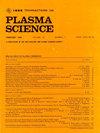双频,谐波,磁绝缘线振荡器
IF 1.3
4区 物理与天体物理
Q3 PHYSICS, FLUIDS & PLASMAS
引用次数: 1
摘要
磁绝缘线振荡器(milo)是一种通过轴向电流产生自激方位磁场的交叉磁场器件。这就否定了对外部磁铁的需求,以降低设备效率为代价,潜在地提高了整体系统效率。本文报道了一种双频谐波MILO (HMILO)的设计、仿真和实验演示,它由两个连续的慢波结构(SWSs)组成,每个慢波结构在不同频率下调谐振荡,每个慢波结构都有一组扼流圈腔,并由公共阴极自生磁场绝缘。在HMILO实验之前,分别在L -和S -频段(1 GHz和2 GHz)设计的两个swss进行了独立测试。L波段MILO (L-MILO)的结果由Packard先前报道。在本文报道的实验中,当MELBA-C发生器提供207 kV和7.3 kA的电压时,隔离的S-MILO (S-MILO)在2.076±0.005 GHz下产生1.1±0.7 MW的输出功率。最终,当实现两种独立的提取器配置时,HMILO在0.984±0.013 GHz时产生12.7±7.6 MW,在2.074±0.003 GHz时产生3.2±1.5 MW。这些结果与粒子池(PIC)代码CST和改进的并发电磁PIC (ICEPIC)的模拟性能进行了比较。本文章由计算机程序翻译,如有差异,请以英文原文为准。
Dual-Frequency, Harmonic, Magnetically Insulated Line Oscillator
Magnetically insulated line oscillators (MILOs) are crossed-field devices which generate a self-induced azimuthal magnetic field via an axial current. This negates the need for external magnets, potentially increasing overall system efficiency at the expense of reduced device efficiency. This article reports the design, simulation, and experimental demonstration of a dual-frequency, harmonic MILO (HMILO), which is composed of two sequential slow wave structures (SWSs) tuned for oscillation at different frequencies, each paired with a set of choke cavities and insulated by the self-generated magnetic field of the common cathode. The two SWSs—designed for operation in
$L$
- and
$S$
-bands at 1 and 2 GHz, respectively—were tested independently before the HMILO experiments. Results for the
$L$
-band MILO (L-MILO) were reported previously by Packard. In the experiments reported here, the isolated
$S$
-band MILO (S-MILO) produced 1.1 ± 0.7 MW of output power at 2.076 ± 0.005 GHz, when supplied with 207 kV and 7.3 kA from the MELBA-C generator. Ultimately, when implementing two separate extractor configurations, the HMILO produced 12.7 ± 7.6 MW at 0.984 ± 0.013 GHz and 3.2 ± 1.5 MW at 2.074 ± 0.003 GHz. These results are compared against simulated performance in the particle-in-cell (PIC) codes CST and improved concurrent electromagnetic PIC (ICEPIC).
求助全文
通过发布文献求助,成功后即可免费获取论文全文。
去求助
来源期刊

IEEE Transactions on Plasma Science
物理-物理:流体与等离子体
CiteScore
3.00
自引率
20.00%
发文量
538
审稿时长
3.8 months
期刊介绍:
The scope covers all aspects of the theory and application of plasma science. It includes the following areas: magnetohydrodynamics; thermionics and plasma diodes; basic plasma phenomena; gaseous electronics; microwave/plasma interaction; electron, ion, and plasma sources; space plasmas; intense electron and ion beams; laser-plasma interactions; plasma diagnostics; plasma chemistry and processing; solid-state plasmas; plasma heating; plasma for controlled fusion research; high energy density plasmas; industrial/commercial applications of plasma physics; plasma waves and instabilities; and high power microwave and submillimeter wave generation.
 求助内容:
求助内容: 应助结果提醒方式:
应助结果提醒方式:


